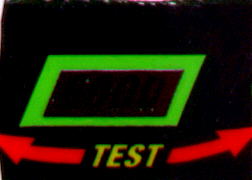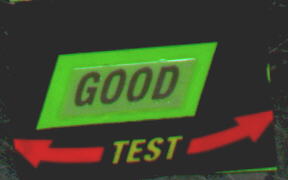Thermochromic Battery Tester (thermochromic leucodye film)
The built-in battery testers on common alkaline batteries are based on films of thermochromic inks called leucodyes. When the test "buttons" on the battery are pushed, a current from the battery flows past the leucodye film, heating it slightly and causing it to lose its color. To check this, I cut the battery tester off an Energizer® "D" cell with a razor blade. At room temperature the film appears dark, but body heat can change the leucodye layer to colorless, exposing a green background layer that provides contrast so the black-lettered word "GOOD" may be read. The Energizer® and Duracell® battery testers checked by Robert Bailey changed color at roughly 40 C.
References:
White, M. A.; LeBlanc, M. "Thermochromism in Commercial Products" J. Chem. Educ., 1999, 76, 1201.
Viiri, J.; Kettunen, L. "Temperature Profile of the Duracell® Test Strip" Phys. Teach., 1996, 34, 276.
Clark, R. W.; Bomicamp, J. M. "Tapered Resistors" Phys. Teach., 1995, 33, 340.
BELOW LEFT: The battery tester at room temperature.
BELOW RIGHT: The battery tester in contact with a metal cup of hot water as a source of heat.


No comments:
Post a Comment